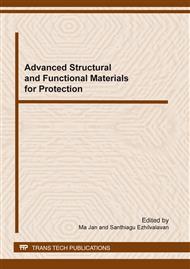p.25
p.28
p.31
p.34
p.37
p.44
p.48
p.51
p.55
Effect of In Doping on Thermoelectric and Magnetoresistive Properties of ZnO Films Prepared by RF Magnetron Sputtering
Abstract:
n-doped ZnO (ZnO:In) thin films with 0~9at.% In content have been prepared by RF high magnetron sputtering on glass substrate. All the films were annealed in N2 at 473K for 1h. The effect of In doping concentration on the structure, surface morphology, electrical properties,Seebeck and magnetoresistive effect of the films were investigated. It was found that the crystal quality of the films degrades, and the surface gets rough with increasing In content. The lowest resistivity of the ZnO:In thin films 6.1×10-4Ω.cm occurs at 5at.% in the target doping concentration. All the films show a striking Seebeck effect and the absolute value of the Seebeck coefficient decreases under magnetic field. Meanwhile, a positive magnetoresistance of the films was found. ZnO thin films with 1at.% In-doped is best for the thermoelectric material, which has the largest power factor of 2.1×10-4W/K2m at room temperature.
Info:
Periodical:
Pages:
37-43
Citation:
Online since:
February 2012
Price:
Сopyright:
© 2012 Trans Tech Publications Ltd. All Rights Reserved
Share:
Citation:


